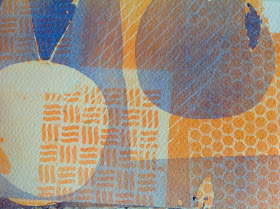First I tried Bubble Jet Set, then it was Ink Aid, now I am
too old or too lazy for either and I decided to go for the printable fabric
option. Now I must say that I think Ink Aid is excellent and have had good
results when printing my photos or other work onto fabric, but the printable
sheets are so easy and go through the printer without one having to hold ones
breath and without all the careful coating of the fabric first, and even better
there is no waiting involved. OK, I admit I am plain lazy. The fabric I used
was non-washable cotton and it is quite thin.
I decided to print a couple of my Gelatine prints onto
fabric to make a new cover for my Kindle. Firstly I had to rephotograph them as
the ipad photos are in low resolution, ideal for the computer, but not ideal
for printing. I then manipulated the colours a little on the computer. I did a
draft print and decided to change the setting to black and white for the image
with words. I also put my name into the print using a Photoshop brush.
The book
I took the pages from was given as a school prize in 1891 so I do not think
there are any copyright issues.
The tag on the side is useful and matches the
lining but I have to admit it was probably not the best choice colour wise.Material left over from when I did my 'Noughts and Crosses' workshop.
I
quilted the lining as I have a slight mark on my Kindle screen where I dropped
it and don’t want any more accidents (that is if I fall out of bed again!) My execution is not perfect but I like it and
it will be useful.
I must let you know that I will now be posting at least once
a month to the Sketchbook Challenge Group, as Sue Bleiweiss kindly asked me to
join the SC team. This month’s theme is Spirals.


















.JPG)




